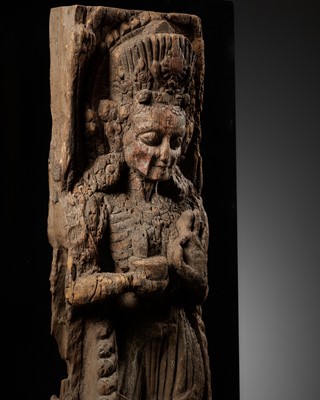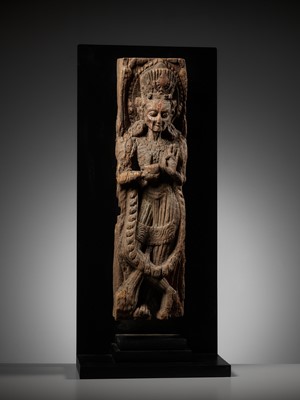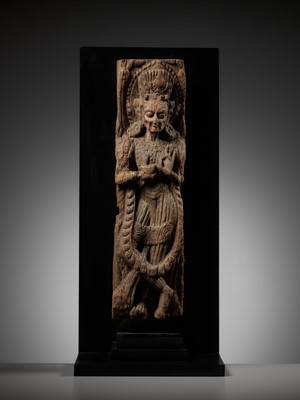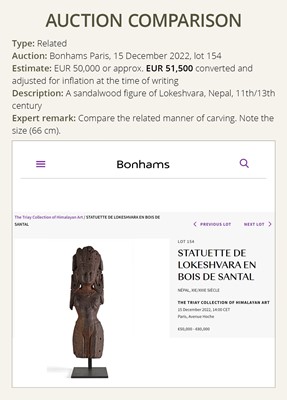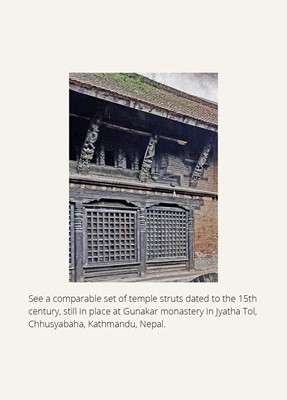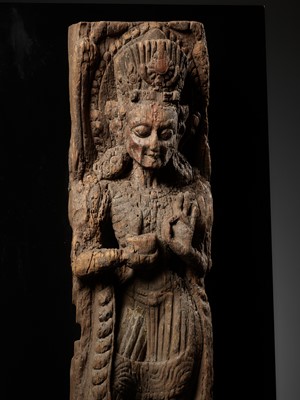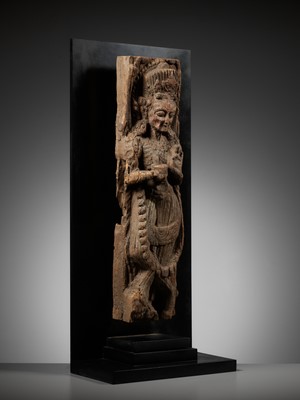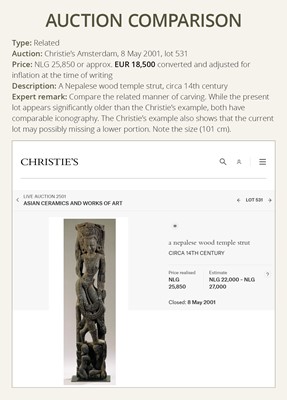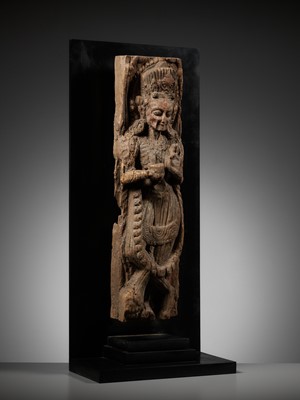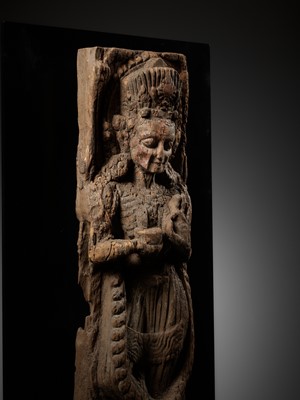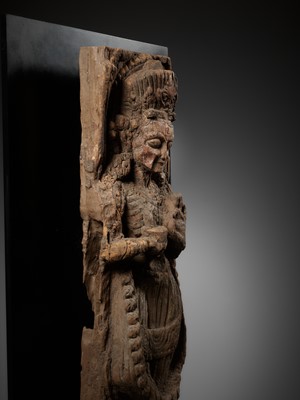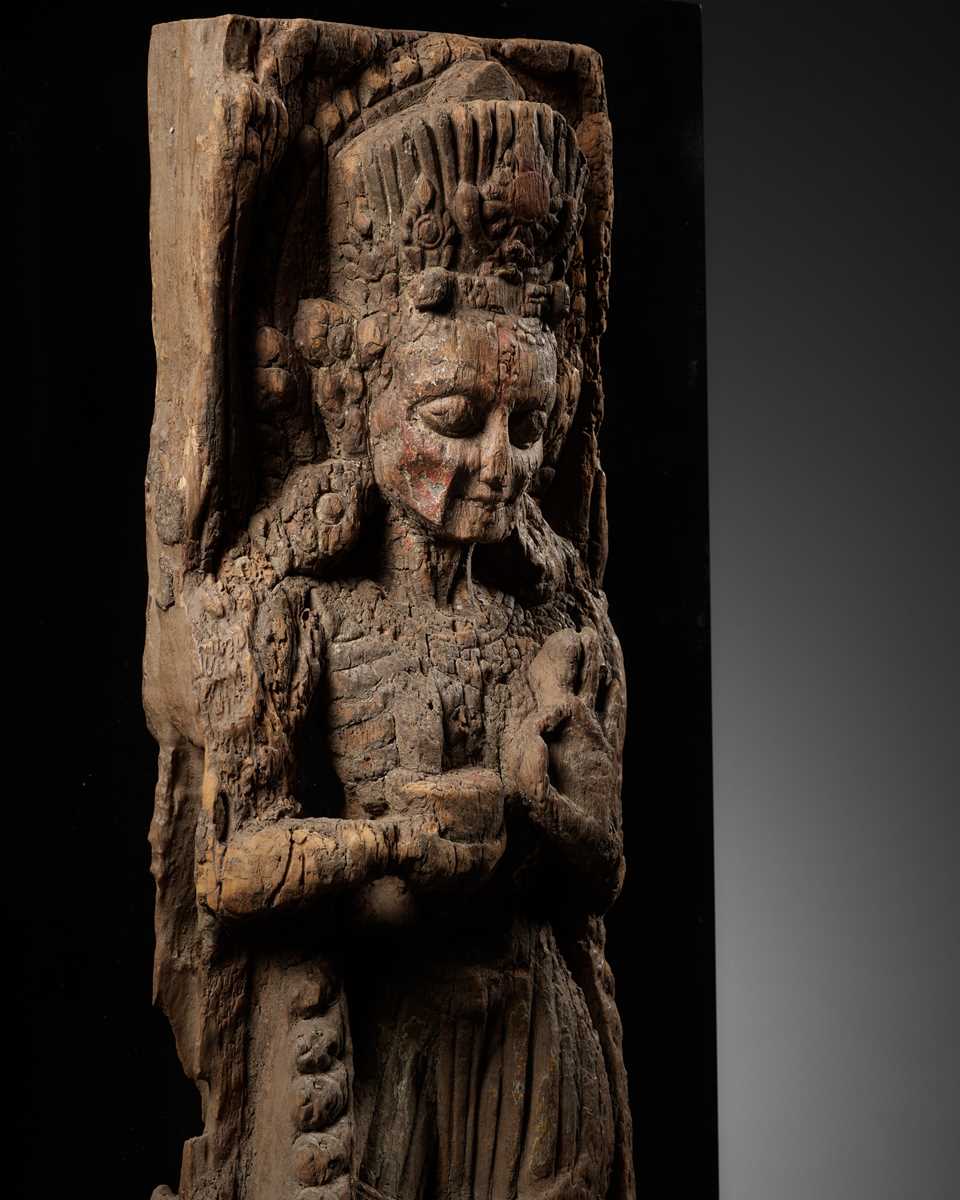13th Dec, 2023 13:00
Fine Asian Art Holiday Sale
1
A RARE CARVED WOOD TEMPLE STRUT (VIGRAHA) DEPICTING A YOGINI
寺廟木柱雕刻瑜伽士
Sold for €2,860
including Buyer's Premium
Nepal, 13th-14th century or earlier. Finely carved standing in tribhanga, the left hand raised in the healing gesture of prithvi mudra, the right holding a skull cup. The emaciated body adorned with a garland of severed heads, the gaunt face with large eyes protruding from cavernous sockets, the head surmounted by an elaborate tiara.
Provenance: From the estate of Richard S. Ravenal (1927-2022), Livingston Manor, New York, USA. The former owner of both the Asian Gallery in New York, Richard Ravenal was an avid collector and connoisseur of East Asian antiquities. Pieces formerly in his possession can be found today in several prominent institutions, including the Brooklyn Museum.
Condition: Good condition, commensurate with age. Ancient wear, expected age cracks and splits, losses, signs of weathering and erosion, minor worming, nicks, scratches. Overall presenting remarkably well. A magnificent, naturally grown patina overall.
Weight: 13.4 kg (incl. stand)
Dimensions: Height 73 cm (excl. stand) and 88.5 cm (incl. stand)
Please click here to read the full description
Mounted on a fitted stand. (2)
Nepalese temple struts, known as tunala or vigraha, are considered fine works of art and are often made by highly skilled craftsmen using traditional techniques. They are an important part of the cultural heritage of Nepal and can be found in many different styles and designs throughout the country. These struts are found in traditional Nepalese architecture, particularly in religious structures such as temples and shrines, ornately carved and often painted, serving both structural and symbolic purposes.
Structurally, the struts help support the roof of the temple or shrine, which is made of heavy timber or stone. The struts are typically placed at regular intervals along the eaves of the roof, and their weight helps to counterbalance the weight of the roof, making the structure more stable.
Symbolically, the struts are often carved with intricate designs and figures from Nepalese mythology, and are believed to have religious significance. They are thought to represent various deities or supernatural beings, and are intended to offer protection and blessings to the structure and its occupants.
Literature comparison:
Compare a related wood temple strut depicting a yakshi, 128 cm high, dated to the 13th century, formerly in the Art Gallery New South Wales, accession number 33.2000.a-b, recently repatriated to Nepal in May 2003 and currently on display at the Patan Museum. Compare a related wood temple strut depicting Varaha, 74.5 cm high, dated to the 15th century, previously in the James W. and Marilynn Alsdorf Collection and now in the Art Institute of Chicago, reference number 1984.1495. See a comparable set of temple struts dated to the 15th century, still in place at Gunakar monastery in Jyatha Tol, Chhusyabaha, Kathmandu, Nepal.
Auction result comparison:
Type: Related
Auction: Christie’s Amsterdam, 8 May 2001, lot 531
Price: NLG 25,850 or approx. EUR 18,500 converted and adjusted for inflation at the time of writing
Description: A Nepalese wood temple strut, circa 14th century
Expert remark: Compare the related manner of carving. While the present lot appears significantly older than the Christie’s example, both have comparable iconography. The Christie’s example also shows that the current lot may possibly be missing a lower portion. Note the size (101 cm).
Auction result comparison:
Type: Related
Auction: Bonhams Paris, 15 December 2022, lot 154
Estimate: EUR 50,000 or approx. EUR 51,500 converted and adjusted for inflation at the time of writing
Description: A sandalwood figure of Lokeshvara, Nepal, 11th/13th century
Expert remark: Compare the related manner of carving. Note the size (66 cm).
点此阅读中文翻译 (Chinese Translation)
寺廟木柱雕刻瑜伽士
尼泊爾,十三至十四世紀或更早。精雕細刻,呈三曲式,左手舉起,結地手印治療姿勢,右手拿著一個骷髏杯。 瘦弱的身體上戴著骷髏花環,憔悴的臉龐,大眼突出,頭上戴著頭飾。
來源:Richard S. Ravenal (1927-2022年) 舊藏,美國紐約利文斯頓莊園。Richard Ravenal是紐約亞洲藝廊的前任所有者,他是一位熱心的東亞古董收藏家和鑑賞家。 如今,包括布魯克林博物館在內的幾個著名機構中都可以找到他以前擁有的藏品。
品相:狀態良好,磨損、裂縫和裂口、缺損、風化和侵蝕、輕微的蟲蛀、刻痕、劃痕,自然包漿。
重量:13.4 公斤(含底座)
尺寸:高 73 厘米 (不含底座) 與 88.5 厘米 (含底座)
固定支架 (2)
文獻比較:
比較一件相近的十三世紀寺廟木雕藥叉女,高128 厘米,曾藏於Art Gallery New South Wales,館藏編號33.2000.a-b,2003年5月已被送回尼泊爾,現藏於Patan 博物館。比較一件相近的十五世紀寺廟木雕婆羅訶,高74.5 厘米,曾藏於James W.和Marilynn Alsdorf Collection,現藏於芝加哥藝術博物館,館藏編號1984.1495。見一件十五世紀寺廟木雕像,仍在尼泊爾加德滿都Jyatha Tol的Gunakar修道院。
拍賣比較:
形制:相近
拍賣:阿姆斯特丹佳士得,2001年5月8日,lot 531
價格:NLG 25,850(相當今日EUR 18,500)
描述:約十四世紀尼泊爾寺廟木雕
專家註釋:比較相近的雕刻風格。 雖然我們的拍品看起來比佳士得的木雕年代更久遠,但兩者的圖像具有可比性。佳士得的例子還表明,我們的拍品可能缺少下部部分。請注意尺寸 (101 厘米)。
拍賣比較:
形制:相近
拍賣:巴黎邦翰斯,2022年12月15日,lot 154
估價:EUR 50,000(相當今日EUR 51,500)
描述:尼泊爾十一/十三世紀檀香木雕聖觀自在菩薩像
專家註釋:比較相近的雕刻風格。請注意尺寸 (66 厘米)。
Nepal, 13th-14th century or earlier. Finely carved standing in tribhanga, the left hand raised in the healing gesture of prithvi mudra, the right holding a skull cup. The emaciated body adorned with a garland of severed heads, the gaunt face with large eyes protruding from cavernous sockets, the head surmounted by an elaborate tiara.
Provenance: From the estate of Richard S. Ravenal (1927-2022), Livingston Manor, New York, USA. The former owner of both the Asian Gallery in New York, Richard Ravenal was an avid collector and connoisseur of East Asian antiquities. Pieces formerly in his possession can be found today in several prominent institutions, including the Brooklyn Museum.
Condition: Good condition, commensurate with age. Ancient wear, expected age cracks and splits, losses, signs of weathering and erosion, minor worming, nicks, scratches. Overall presenting remarkably well. A magnificent, naturally grown patina overall.
Weight: 13.4 kg (incl. stand)
Dimensions: Height 73 cm (excl. stand) and 88.5 cm (incl. stand)
Please click here to read the full description
Mounted on a fitted stand. (2)
Nepalese temple struts, known as tunala or vigraha, are considered fine works of art and are often made by highly skilled craftsmen using traditional techniques. They are an important part of the cultural heritage of Nepal and can be found in many different styles and designs throughout the country. These struts are found in traditional Nepalese architecture, particularly in religious structures such as temples and shrines, ornately carved and often painted, serving both structural and symbolic purposes.
Structurally, the struts help support the roof of the temple or shrine, which is made of heavy timber or stone. The struts are typically placed at regular intervals along the eaves of the roof, and their weight helps to counterbalance the weight of the roof, making the structure more stable.
Symbolically, the struts are often carved with intricate designs and figures from Nepalese mythology, and are believed to have religious significance. They are thought to represent various deities or supernatural beings, and are intended to offer protection and blessings to the structure and its occupants.
Literature comparison:
Compare a related wood temple strut depicting a yakshi, 128 cm high, dated to the 13th century, formerly in the Art Gallery New South Wales, accession number 33.2000.a-b, recently repatriated to Nepal in May 2003 and currently on display at the Patan Museum. Compare a related wood temple strut depicting Varaha, 74.5 cm high, dated to the 15th century, previously in the James W. and Marilynn Alsdorf Collection and now in the Art Institute of Chicago, reference number 1984.1495. See a comparable set of temple struts dated to the 15th century, still in place at Gunakar monastery in Jyatha Tol, Chhusyabaha, Kathmandu, Nepal.
Auction result comparison:
Type: Related
Auction: Christie’s Amsterdam, 8 May 2001, lot 531
Price: NLG 25,850 or approx. EUR 18,500 converted and adjusted for inflation at the time of writing
Description: A Nepalese wood temple strut, circa 14th century
Expert remark: Compare the related manner of carving. While the present lot appears significantly older than the Christie’s example, both have comparable iconography. The Christie’s example also shows that the current lot may possibly be missing a lower portion. Note the size (101 cm).
Auction result comparison:
Type: Related
Auction: Bonhams Paris, 15 December 2022, lot 154
Estimate: EUR 50,000 or approx. EUR 51,500 converted and adjusted for inflation at the time of writing
Description: A sandalwood figure of Lokeshvara, Nepal, 11th/13th century
Expert remark: Compare the related manner of carving. Note the size (66 cm).
点此阅读中文翻译 (Chinese Translation)
寺廟木柱雕刻瑜伽士
尼泊爾,十三至十四世紀或更早。精雕細刻,呈三曲式,左手舉起,結地手印治療姿勢,右手拿著一個骷髏杯。 瘦弱的身體上戴著骷髏花環,憔悴的臉龐,大眼突出,頭上戴著頭飾。
來源:Richard S. Ravenal (1927-2022年) 舊藏,美國紐約利文斯頓莊園。Richard Ravenal是紐約亞洲藝廊的前任所有者,他是一位熱心的東亞古董收藏家和鑑賞家。 如今,包括布魯克林博物館在內的幾個著名機構中都可以找到他以前擁有的藏品。
品相:狀態良好,磨損、裂縫和裂口、缺損、風化和侵蝕、輕微的蟲蛀、刻痕、劃痕,自然包漿。
重量:13.4 公斤(含底座)
尺寸:高 73 厘米 (不含底座) 與 88.5 厘米 (含底座)
固定支架 (2)
文獻比較:
比較一件相近的十三世紀寺廟木雕藥叉女,高128 厘米,曾藏於Art Gallery New South Wales,館藏編號33.2000.a-b,2003年5月已被送回尼泊爾,現藏於Patan 博物館。比較一件相近的十五世紀寺廟木雕婆羅訶,高74.5 厘米,曾藏於James W.和Marilynn Alsdorf Collection,現藏於芝加哥藝術博物館,館藏編號1984.1495。見一件十五世紀寺廟木雕像,仍在尼泊爾加德滿都Jyatha Tol的Gunakar修道院。
拍賣比較:
形制:相近
拍賣:阿姆斯特丹佳士得,2001年5月8日,lot 531
價格:NLG 25,850(相當今日EUR 18,500)
描述:約十四世紀尼泊爾寺廟木雕
專家註釋:比較相近的雕刻風格。 雖然我們的拍品看起來比佳士得的木雕年代更久遠,但兩者的圖像具有可比性。佳士得的例子還表明,我們的拍品可能缺少下部部分。請注意尺寸 (101 厘米)。
拍賣比較:
形制:相近
拍賣:巴黎邦翰斯,2022年12月15日,lot 154
估價:EUR 50,000(相當今日EUR 51,500)
描述:尼泊爾十一/十三世紀檀香木雕聖觀自在菩薩像
專家註釋:比較相近的雕刻風格。請注意尺寸 (66 厘米)。
Zacke Live Online Bidding
Our online bidding platform makes it easier than ever to bid in our auctions! When you bid through our website, you can take advantage of our premium buyer's terms without incurring any additional online bidding surcharges.
To bid live online, you'll need to create an online account. Once your account is created and your identity is verified, you can register to bid in an auction up to 12 hours before the auction begins.
Intended Spend and Bid Limits
When you register to bid in an online auction, you will need to share your intended maximum spending budget for the auction. We will then review your intended spend and set a bid limit for you. Once you have pre-registered for a live online auction, you can see your intended spend and bid limit by going to 'Account Settings' and clicking on 'Live Bidding Registrations'.
Your bid limit will be the maximum amount you can bid during the auction. Your bid limit is for the hammer price and is not affected by the buyer’s premium and VAT. For example, if you have a bid limit of €1,000 and place two winning bids for €300 and €200, then you will only be able to bid €500 for the rest of the auction. If you try to place a bid that is higher than €500, you will not be able to do so.
Online Absentee and Telephone Bids
You can now leave absentee and telephone bids on our website!
Absentee Bidding
Once you've created an account and your identity is verified, you can leave your absentee bid directly on the lot page. We will contact you when your bids have been confirmed.
Telephone Bidding
Once you've created an account and your identity is verified, you can leave telephone bids online. We will contact you when your bids have been confirmed.
Classic Absentee and Telephone Bidding Form
You can still submit absentee and telephone bids by email or fax if you prefer. Simply fill out the Absentee Bidding/Telephone bidding form and return it to us by email at office@zacke.at or by fax at +43 (1) 532 04 52 20. You can download the PDF from our Upcoming Auctions page.
How-To Guides
How to Create Your Personal Zacke Account
How to Register to Bid on Zacke Live
How to Leave Absentee Bids Online
How to Leave Telephone Bids Online
中文版本的操作指南
创建新账号
注册Zacke Live在线直播竞拍(免平台费)
缺席投标和电话投标
Third-Party Bidding
We partner with best-in-class third-party partners to make it easy for you to bid online in the channel of your choice. Please note that if you bid with one of our third-party online partners, then there will be a live bidding surcharge on top of your final purchase price. You can find all of our fees here. Here's a full list of our third-party partners:
- 51 Bid Live
- EpaiLive
- ArtFoxLive
- Invaluable
- LiveAuctioneers
- the-saleroom
- lot-tissimo
- Drouot
Please note that we place different auctions on different platforms. For example, in general, we only place Chinese art auctions on 51 Bid Live.
Bidding in Person
You must register to bid in person and will be assigned a paddle at the auction. Please contact us at office@zacke.at or +43 (1) 532 04 52 for the latest local health and safety guidelines.
